Welcome to week two of my Fabric Collage Review. This six-week refresher (or introduction) on the basics of fabric collage is in preparation for my upcoming live follow-along Zoom classes beginning in February (see below for info and registration)—however, it could also serve as a quiet distraction in a busy time of year—a way to at least mentally immerse yourself in some creative fabric-play.
In last week’s Saturday post, we covered choosing fabric. Today in Create a Palette for Fabric Collage (following below), I show how to use your chosen fabrics to make a fabric collage palette, a useful and freeing step that loosens up your approach to a collage and facilitates creativity with any subject. Over the next four weeks, we will continue to concentrate on preparatory steps related to a fabric collage project. So one way or another, if you subscribe to a four-week Follow-Along or not, you’ll be ready for a colorful and fabulous beginning to the New Year.
And for today, December 21st, may you have a lovely Winter Solstice—or Summer Solstice if you live in the Southern Hemisphere—enjoying either the magic of the longest night of the year, or the energy of the longest day. All the best to you in this season of light, warmth, and connection with others.
* * * * * *
The Fantastical Fish Follow Along in February, will use a fish pattern (of your own design or one which you may choose free from my collection) with a 2025 focus on “blending”—one of my most asked about skills—the process of using the colors and prints in fabrics to merge one into another, often to create the illusion of form, with highlights and shadows.
The Bugs and Butterflies Follow Along (also your own design or based on my patterns) will focus on butterflies and how to approach the flowing and colorful shapes of their fascinating wings. Learn what to look for in your fabrics and how to work with their printed designs to create movement and form—letting the fabric do much of the work for you.
Use the links below to register for these four-week classes, held each Thursday night at 7:00 p.m. eastern time.
In the meantime, especially if you are new to fabric collage, it may be helpful to review the basics through this current series of posts covering the fabric collage technique before these classes begin. In following posts we’ll continue with the topics of glueing, working in sequence, backgrounds, and sheers.
* * * * * *
February 6, 13, 20, 27, 2025 — 7 pm, Eastern Time
Fantastical Fabric Collage Fish Zoom Follow-Along
REGISTER HERE
Price: $78
* * * * * *
July 24, 31, August 7, 14, 2025 — 7 pm, Eastern Time
Fascinating Fabric Collage Bugs and Butterflies Zoom Follow-Along
REGISTER HERE
Price: $78
If you’ve ever considered giving yourself the gift of a 5-day week-long fabric collage class experience with me—and are not scared off by staying cozy in your home, not traveling anywhere, and keeping your fabric stash close by—do we have a special offer for you—a $100 discount (which gives you the opportunity to add more fabric to that stash!).
January 20-24, 2025
Susan Carlson 5-Day Live Online Class—All Levels, Animals Only
Price WAS: $995
NOW: $895
REGISTER HERE
Take advantage of this special offer only for January’s “Cozy” Live Online Fabric Collage Class
Further Susan Carlson Learning Resources: Susan Carlson Quilts website, patterns, blog (in general), YouTube videos, Spiral eWorkshop, Patreon, and our February Fantastical Fish and Summertime’s Fascinating Bugs and Butterfly Work-Alongs
Create a Palette for Fabric Collage
First published October 31, 2020
A painter’s main tool, beside her brushes, is her palette. For each painting, an artist chooses from her countless tubes of paint just the ones she wants for this particular image. She squeezes out a dab of this and a dab of that until she has the entire range of colors and values she wants to use.
I want you to look at your fabric as your palette. Now don’t misunderstand: You may have stacks and stacks of fabric, but that is not your palette. Think of those as your tubes of paint. You have to narrow those choices down. And most importantly, just as you can’t use the paint when it’s still in the tube, you can’t use your fabric when it’s in a huge chunk of a yard or more.
What to do?
When creating the turtle quilt from my Fabric Collage: Sea Turtle eWorkshop, my palette was always close by and was arranged by value, light to dark (see photo at beginning of post). Because my palette was nearby and organized, it was easy to zero in on just the right choice of fabric.
Well, what I’ve been telling my fabric collage students more and more, is to make a fabric palette before they begin their collage. I have them select a range of fabrics. The colors don’t matter as much as the values do. Your subject can be any color you want, but in order to give your subject form you need to have a complete range of values. From the lightest highlight to the darkest shadow, you need a fabric that fills those niches.
Once they’ve selected their fabrics, I have them cut out hand-sized chunks of the fabric, following the prints in the fabric as a guide, NOT cutting directly across and through the print design. Once the pieces are cut out, they’re arranged according to value, from light to dark.
This, then, is the fabric collage palette.
It’s important when creating your palette to avoid cutting your fabrics into similar sized shapes. Create a palette with a variety of shapes by letting the design or print in the fabric dictate where you cut. In this example from my 2020 Thursday Night in My Studio Live! presentations, “Is It Drafty in Here? Working in Drafts”, take a look at the variety of shapes included in the palette for my colorful spiral. Organic or irregular cut pieces of fabrics blend together better than those that are cut in a repeated shape. Note how the fabrics in my palette blend together when placed next to each other.
I’ve always kept a palette of fabrics nearby as I worked on a collage, though not always in an organized sort of way. The idea of encouraging my students to pre-cut their palette and organize to values, grew out of a situation in which I was teaching a class but there was a 24-hour delay in having a few students’ patterns enlarged. To occupy their time in a productive way, I had them look at their fabrics and create their palettes. Even though they had to wait until the second day to start placing their cut fabric shapes, they actually made as much or more progress on their collages by the end of that day than many other students in the class.
The usefulness of teaching this way of working was immediately obvious to me.
However.
It’s not easy to convince students that all this cutting into of their perfectly fine un-cut fabrics is a worthwhile effort, when they don’t even know if these fabrics will, in the end, even work in their collages. I understand that it’s a leap-of-faith investment of time to create a palette before starting to collage. And many of my students are simply so excited to get started that they skip ahead of this step. I just know that from what I’ve seen from their experiences with fabric collage, I’m going to emphasize it more and more in the class curriculum.
I’ve always considered fabric collage to be painting with fabric. I have developed the technique to be as immediate as possible, like painting: I avoid the making of templates; I use glue from a bottle rather than fusible adhesive; and I prep my fabrics by creating a palette. These methods all help me concentrate on collaging the image with my pre-cut shapes, rather than interrupting the process by searching through stacks of fabric again and again.
Pre-cutting a palette of fabrics for your fabric collage allows you to audition, place, and easily trim each piece. Try one fabric, reject it, choose another, trim it down, pin in place. Move on to the next open area.
Arranging your palette by value helps you zero in on the fabric you’re looking for. Are you working on a highlight such as the tip of the nose or cheek? You know where your lightest valued fabrics are already. Working on a shadow on the side of your dog’s head? Here are the darkest values of fabrics.
For my Facial Features eWorkshop, I demonstrate the portrait exercise above. Notice how I’ve arranged my palette around the design from light to dark. Not only that, but the light fabrics and dark fabrics are placed near the side where they’ll be used, the lights on the left, the darks on the right. The cut shapes don’t get used in their entirety, I end up using sections of each—parts of them here and there. As I do so, the hand-sized pieces get reduced in size, as do the open areas I need to fill.
When you initially create your fabric collage palette, that doesn’t mean you can’t and won’t add to it. A palette of 12 – 15 cuts of fabric is a good number to start with, it gets you going with as little fuss as possible. But you may find as you progress, that you need another fabric color, print, or value to fill a particular niche. That’s fine. It’s expected, even. You’re learning what you need as you move ahead.
I hope creating a palette helps you begin and keep going on your fabric collage journey. I believe it is one of the simplest ways to give yourself a head start on your next project.
For a Sun Portrait project based on my sun portrait pattern, I cut the fabric palette above. Admittedly I got a little carried away with my initial selection (but I’m really looking forward to working with them). I have placed my palette onto the center section of a tri-fold presentation/display foam board. Below are photos showing how the sides of the board are hinged so that it can be closed up and will protect my fabrics when they’re not in use. I thought this was a particularly clever idea. I mentioned it to Tom noting that my palette would now be safe from my curious studio cat, Djinni: “In case she decides to nap on them, knock them around or, you know, puke on them.” No sooner had I closed the shutters on my palette than Djinni hopped onto the table and hacked up her breakfast onto the folded up board, proving my hypothesis that yes indeed, a foldable palette surface could save my fabric shapes from the cat.
I encourage my fabric collage students to go wild with color and pattern, especially when their subject is something like a Quilter’s Fantastical Trophy Fish (above). But how to do you use those wild and crazy fabrics? How do you create a fabric palette to work from?
In the video below, excerpted from my Susan Carlson Fabric Collage: Fantastical Fish eWorkshop. I purposely chose some of the strongest patterned and colorful fabrics I could find in my stash to create a fabric palette for my work-along fish: printed batiks, Kaffe Fasset, Jane Sassaman, Australian Aboriginal, African batik, and several novelty prints. In fact, I even mixed these styles of fabrics in my fish collage. I wanted my viewers to know that they can use a variety of favorite fabrics in a collage.
In the video below, I show how I prepared my fishy palette by cutting out hand-sized chunks from my selection, trimming them in such a way that even these very different-colored and -patterned fabrics start to work together. This ability to blend fabrics from one to the next is at the heart of how I create a fabric collage.
And it all starts with the palette.
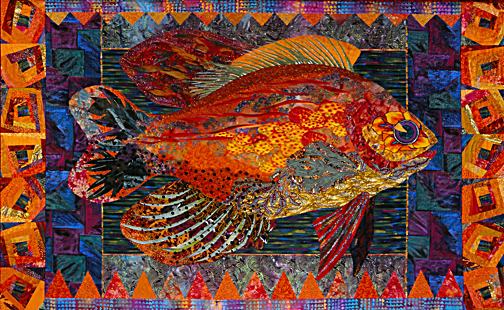
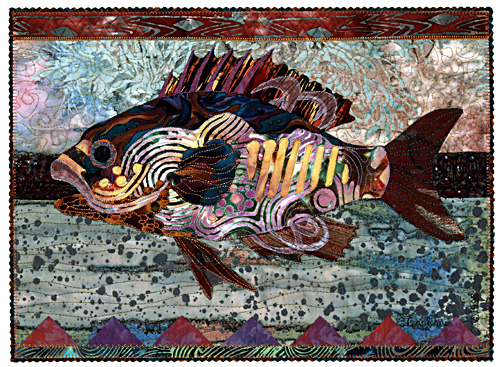
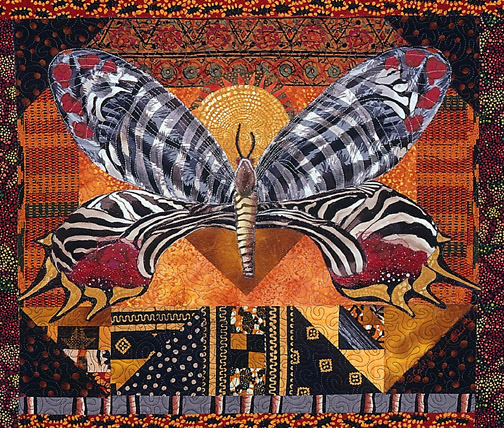
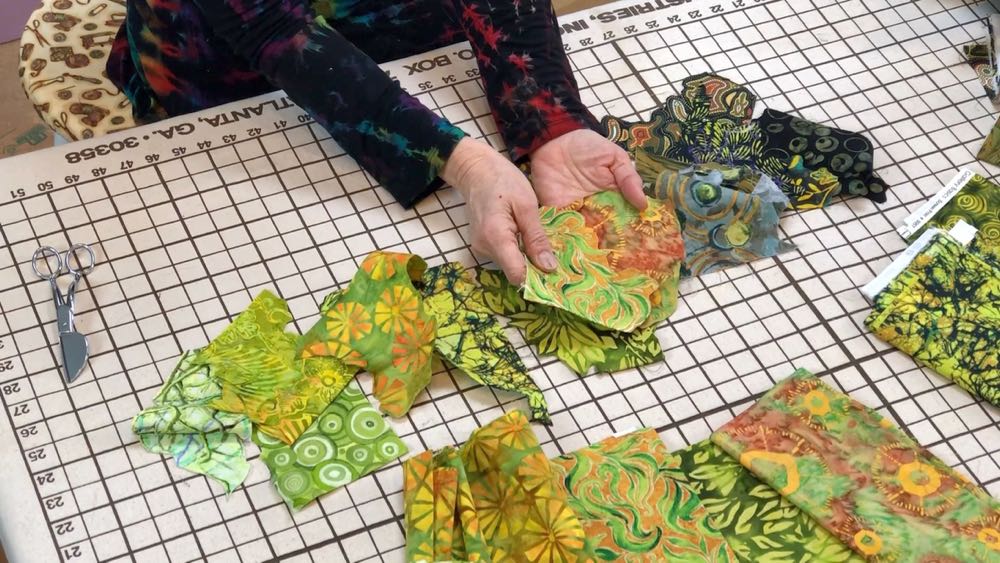



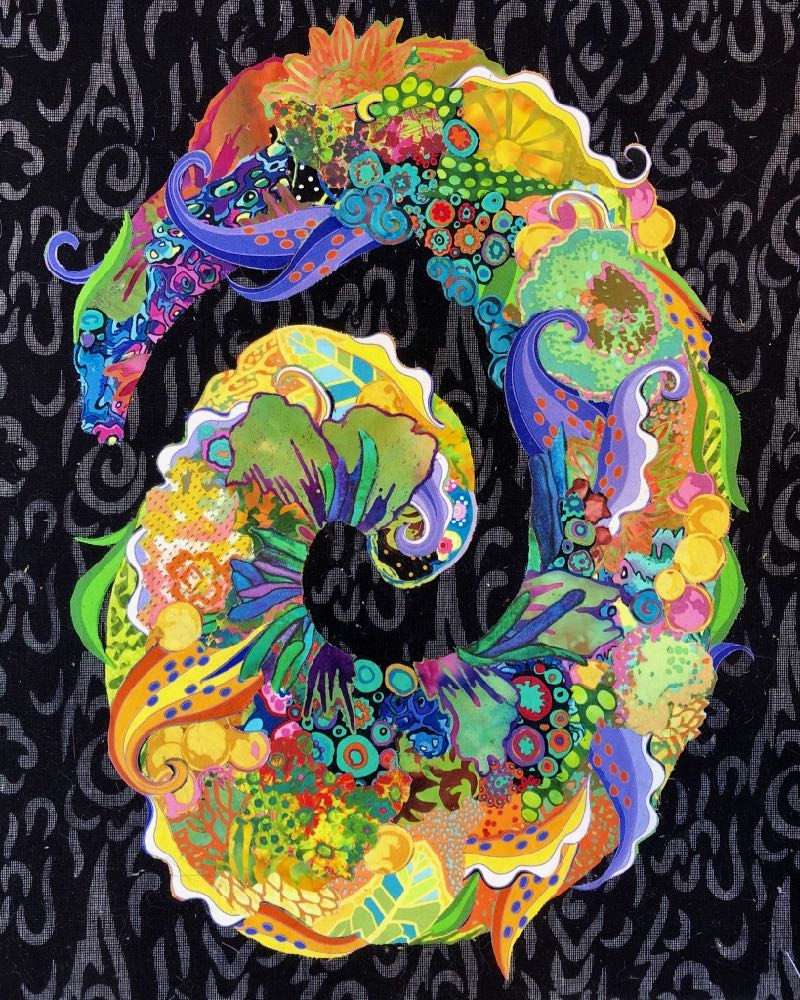





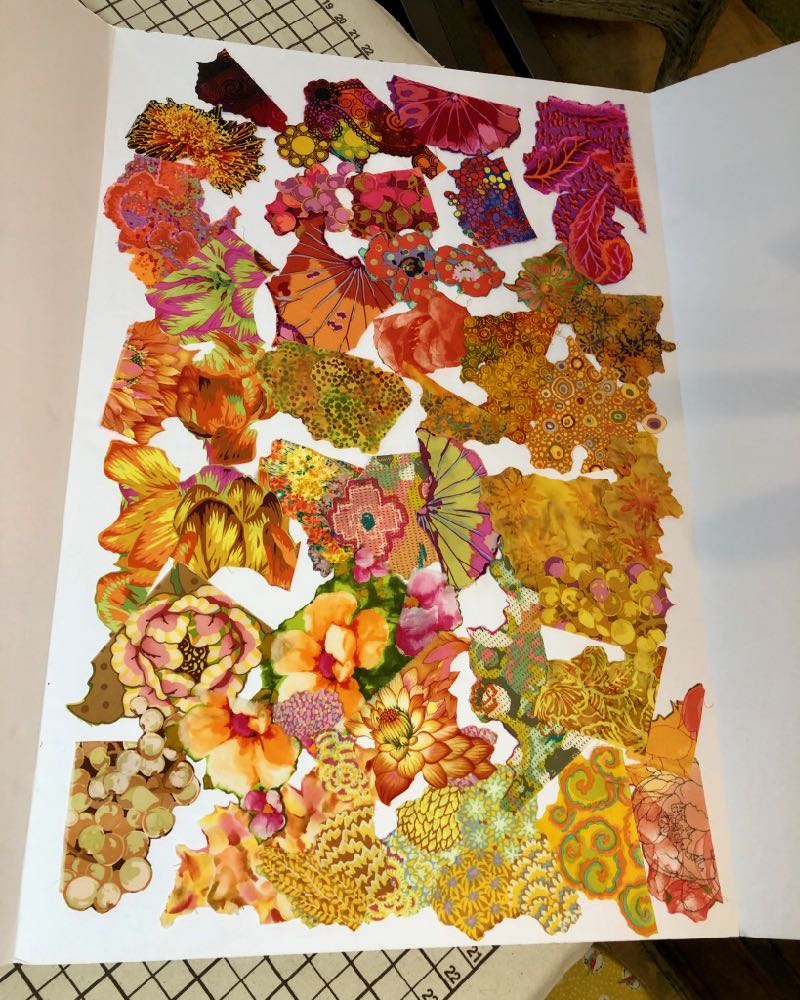



One Comment